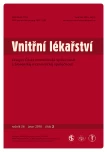A case study of a young male patient with subacute constrictive pericarditis
Authors:
M. Plachý 1; J. Špác 1; M. Souček 1; O. Hlinomaz 2; V. Feitová 3
Authors‘ workplace:
II. interní klinika Lékařské fakulty MU a FN u sv. Anny Brno, přednosta prof. MU Dr. Miroslav Souček, CSc., 2I. interní kardio‑angiologická klinika Lékařské fakulty MU a FN u sv. Anny Brno, přednosta prof. MU Dr. Jiří Vítovec, CSc., FESC, 3Klinika zobrazo
1
Published in:
Vnitř Lék 2010; 56(2): 149-153
Category:
Case Reports
Overview
Chronic constrictive pericarditis (CP) is a disorder affecting pericardium, that becomes inelastic, rigid and restricts filling of the ventricles. Most commonly CP evolves after acute pericarditis, typical is a long‑lasting asymptomatic phase with development of right heart failure and low systemic output. The case report refers CP, which developed in 33 years old patient in a short period after acute idiopatic pericarditis. The patient suffered from severe congestive heart failure with oedema and pleural effusion. At first this diagnosis had not been thought of, the differential diagnosis was focused at primary lung disorder or autoimunne disease. After the true causation had been revealed, pericardectomy was performed with optimal effect and consequential complete recovery. Unfortunately the etiology of CP wasn’t discovered. CP is in Europe a relatively rare disease, particularly in such young patients. Determining the correct diagnosis and treatment is vital to be done as soon as possible to prevent increase of surgery risk and probability of post‑operative diastolic abnormalities.
Key words:
constrictive pericarditis – idiopathic pericarditis – echocardiography – right heart catheterisation with tonometry
Sources
1. Riedel M. Konstriktivní perikarditida. Kardiol Rev 2003, 2: 69– 75.
2. Hancock EW. Differential diagnosis of restrictive cardiomyopathy and constrictive pericarditis. Heart 2001; 86: 343– 349.
3. Myers RBH, Spodick DH. Constrictive pericarditis: clinical and pathophysiologic characteristics. Am Heart J 1999; 138: 219– 232.
4. Goldstein JA. Cardiac Tamponade, Constrictive Pericarditis, and Restrictive Cardiomyopathy. Curr Probl Cardiol 2004; 29: 503– 567.
5. Rajagopalan N, Garcia MJ, Rodriguez L et al. Comparison of new doppler echocardiographic methods to differentiate constrictive pericardial heart disease and restrictive cardiomyopathy. Am J Cardiol 2001; 87: 86– 94.
6. Oh JK, Hatle LK, Seward JB et al. Diagnostic role of doppler echocardiography in constrictive pericarditis. J Am Coll Cardiol 1994; 23: 154– 162.
7. Ha JW, Ommen SR, Tajik AJ et al. Differentiation of constrictive pericarditis from restrictive cardiomyopathy using mitral annular velocity by tissue Doppler echocardiography. Am J Cardiol 2004; 94: 316– 319.
8. Wang ZJ, Reddy GP, Gotway MB et al. CT and MR imaging of pericardial disease. Radiographics 2003; 23: S167– S180.
9. Hoit BD. Management of effusive and constrictive pericardial heart disease. Circulation 2002; 105: 2939– 2942.
10. Senni M, Redfield MM, Ling LH et al. Left ventricular systolic and diastolic function after pericardectomy in patients with constrictive pericarditis. J Am Coll Cardiol 1999; 33: 1182– 1188.
Labels
Diabetology Endocrinology Internal medicineArticle was published in
Internal Medicine

2010 Issue 2
Most read in this issue
- Central diabetes insipidus in adult patients – the first sign of Langerhans cell histiocytosis and Erdheim‑Chester disease. Three case studies and literature review
- Risk of long‑term antisecretory treatment with proton pump inhibitors
- A case study of a young male patient with subacute constrictive pericarditis
- Direct renin inhibitor aliskiren in the treatment of cardiovascular and renal diseases
